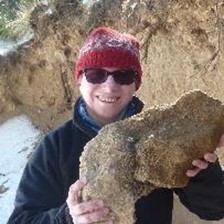The Society’s Distinguished Lecturers for 2025–26 have been selected. They are Chiara Petrone (Natural History Museum, London) and Simon Hunt (University of Manchester).
If you would like to request a Distinguished Lecture at your organization/university, please complete the attached form and return it to the Society’s Executive Director by 14th November 2025.


(left) Chiara Petrone, Natural History Museum, London
(right) Simon Hunt, University of Manchester
Chiara Petrone
Lecture A – Petrological monitoring of active volcanoes one crystal at a time
Volcanic eruptions are spectacular displays of nature’s incredible power, but they put local communities at risk. Approximately 800 million people worldwide live within 100 km of a volcano that is currently erupting or has the potential to erupt in the future. Our ability to mitigate their hazard relies on empirical analyses of monitoring data, with large uncertainties in estimating the probability of an eruption and its impact.
Forecasting the size, duration and hazards of eruptions requires a deep understanding of magma transport and storage and quantifying the timescales of the processes occurring beneath the surface. The relationship between these sub-surficial processes and geophysical and geochemical observations made at the surface is key to understand volcanoes behaviour.
The minerals within the rocks erupted during volcanic eruptions are an incredible archive of information. They act like a probe into the volcano’s interior, allowing us to decode its behaviour and inform volcanic hazards assessment. Drawing from examples of some of the most active volcanoes in the world – such as Popocatepetl and Colima in Mexico, and Stromboli and Etna in Italy – this talk will take you on a journey inside the volcano factory, exploring the hidden processes that drive eruptions.
Lecture B – The journey of volcanic crystals: the time lords of eruptive history
The crystal cargo of volcanic rocks is a heterogeneous assemblage of mineral populations of different origins and age ranges, recording complex histories of their journey through the volcano plumbing system prior to eruption. Timescales of pre-eruptive magmatic processes can be unlocked via elemental diffusion chronometry, a powerful and widely used tool exploiting the element exchange within a chemically zoned crystal or within a crystal and melt.
Durations of pre-eruptive magmatic processes are quite variable and are system dependent. Timescales of magma storage between magma intrusion and eruption is relative short (from a few days to a few decades) for basaltic systems, but much longer (decades to millennia) for silicic systems. The short timescales recorded by crystals from mafic and intermediate volcanoes often match those recorded by monitoring signals (e.g., gas, seismicity, deformation, etc) and offer valuable information to inform volcano forecasting and hazards mitigation. Timescales of magma remobilisation and pre-existing crystals remobilisation, retrieved from the internal portions of chemically zoned crystals, provide information on the longevity of crystal mushes and are shedding new light particularly on basaltic crystal mushes, which may persist longer than previously hypothesised.
Here, using recent examples from both terrestrial and extraterrestrial volcanoes, I will discuss how diffusion chronometry provides fundamental time-constrained insights into pre-eruptive magma dynamics. I will also focus on the challenges we face to progress diffusion chronometry, reducing uncertainties and favouring interdisciplinary approaches that link diffusion chronometry to real-time volcano observations and isotope geochemistry.
Simon Hunt
Lecture C – Exploiting everything in the observations or experimental data
Cutting edge research often requires maximising the exploitation of experimental data, and the things that are hidden in it. This is epitomised by recent advances in experimental and observational data sets that are outrunning the methods used to process the data. Coupled with sophisticated software packages that process data using standard techniques there is a reasonable probability that potential cutting-edge observations are missed.
Using examples of developments in both experimental methods and data analysis we can explore the limits of what is available in experimental data; without which science does not progress as quickly.
Lecture D – Experimental investigations of the Earth’s inner core
The Earth’s inner core is a viscoelastic body, the age and chemistry of which are poorly understood. Age estimates for the inner core range from ~4 Ga to ~0.5 Ga. Understanding the chemistry and age of the inner-core are critical parts of understanding the Earth’s magnetic field and its changes with time. To advance understanding of the inner core we have been performing experiments to understand the evolution and behaviour of metals close to their melting temperatures – with a view to interpreting the seismic behaviour of the Earth’s inner-core and its evolution with time.